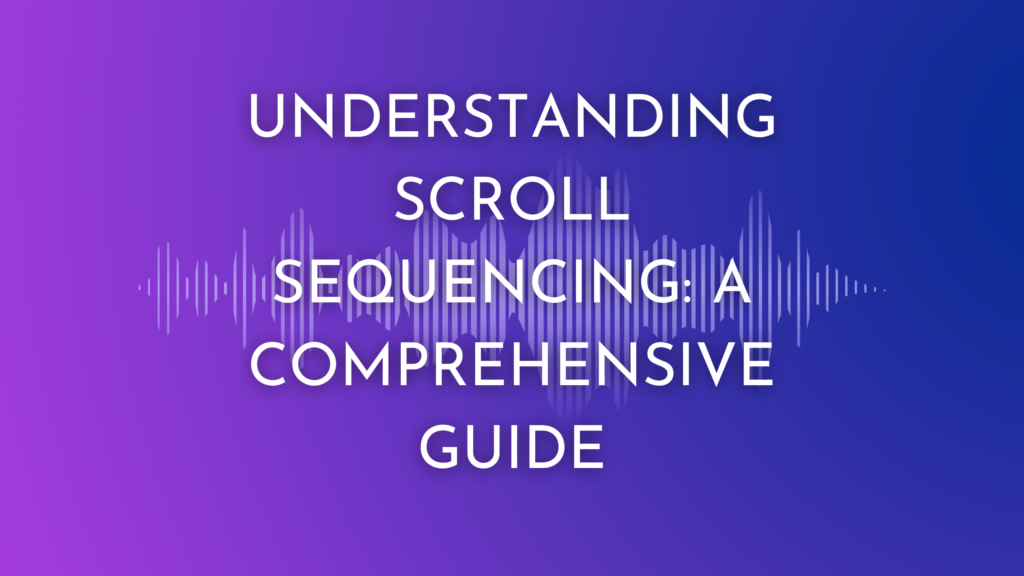Introduction to Scroll Sequencing
Scroll sequencing is a term that has been buzzing around the digital marketing and user experience circles lately. It refers to the technique of using animations and scrolling effects to guide users through a website’s content. While it has been around for a while, scroll sequencing has gained more attention recently as website designers and marketers look for ways to engage users and improve their experience. This article will provide a comprehensive guide to scroll sequencing, its benefits, and how to implement it on your website.
What is Scroll Sequencing?
Scroll sequencing is a technique of using animations and scrolling effects to guide users through a website’s content. It involves breaking down a long-form content page into smaller sections or sequences and animating each section’s transition as the user scrolls. By doing so, the technique creates a more interactive and engaging experience for the user, making it easier for them to consume the content.
Scrollsequence – How Scroll Sequencing works
Benefits of Scroll Sequencing
- There are numerous benefits to using scroll sequencing on your website, including:
Improved User Engagement: Scroll sequencing can help increase user engagement by making the browsing experience more interactive and fun. It also helps keep users on your website for longer periods.
Better Content Consumption: With scroll sequencing, users can easily navigate through your website’s content. The animations and transitions help break down the content into smaller, digestible sections, making it easier for users to consume. - Increased Conversions: Scroll sequencing can help increase conversions by keeping users engaged and on your website for longer periods. This can result in more time for users to explore your products or services, leading to increased conversions.
Implementing Scroll Sequencing on Your Website
Here are some tips to help you implement scroll sequencing on your website:
- Plan Your Content: Before implementing scroll sequencing, plan your content to determine the sequences or sections you want to break it into. This will help you determine the animations and transitions you need to use.
Choose the Right Animations: Select animations that complement your content and enhance the user experience. Avoid animations that are distracting or take too long to load.
Use a Responsive Design: Ensure your scroll sequencing is optimized for different screen sizes and devices. A responsive design will help ensure a seamless browsing experience for all users.
Alternative to scroll sequencing:
While scroll sequencing can be an effective technique for guiding users through a website’s content, it’s not the only option available. One alternative to scroll sequencing is a more traditional approach to page design: breaking up content into smaller, more manageable chunks.
Rather than relying on animations and scrolling effects, this approach involves dividing a long-form content page into smaller sections with clear headings and subheadings. Each section should be brief, concise, and focused on a single topic or idea. This makes it easier for users to scan the page and quickly find the information they’re looking for.
To make this approach even more effective, consider using visual elements like images, infographics, and videos to break up the text and make the page more visually appealing. You can also use design elements like white space, typography, and color to create a more pleasing and readable layout.
The benefit of this approach is that it’s simple and straightforward, making it easy for users to understand and navigate. It’s also more accessible for users who may have difficulty with scrolling or animations.
Of course, every website is different, and what works best for one may not work for another. It’s always a good idea to test different approaches and see what works best for your audience and content. But if you’re looking for an alternative to scroll sequencing, breaking up content into smaller, more manageable chunks is a tried-and-true approach that’s worth considering.
Conclusion
Scroll sequencing is an effective technique that can help improve user engagement, content consumption, and conversions on your website. By breaking down your content into smaller sections and animating transitions, you can create an interactive and engaging browsing experience for your users. To implement scroll sequencing successfully, ensure you plan your content, choose the right animations, and use a responsive design. With these tips, you can use scroll sequencing to take your website’s user experience to the next level.


